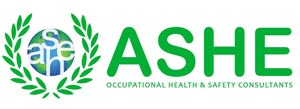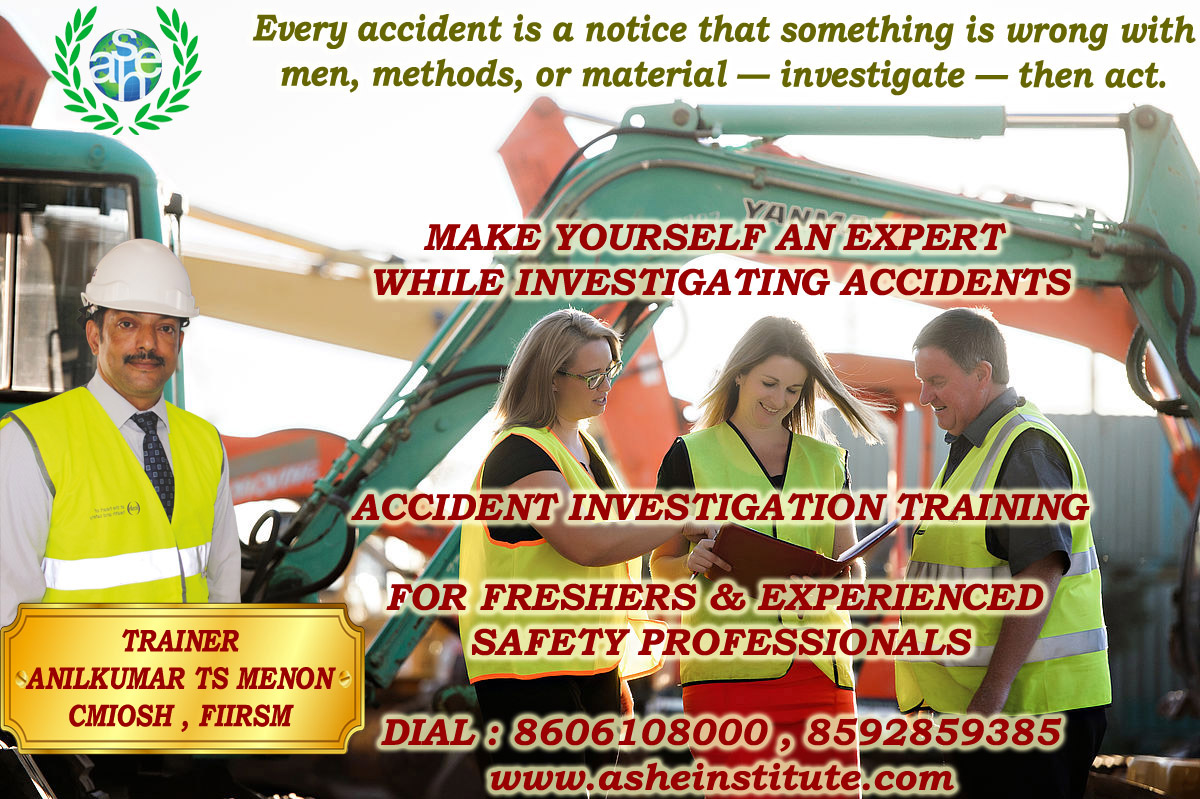Accident Investigation
WHAT IS IT?
Accident investigation is the process of determining the root causes of accidents, on-the-job injuries, property damage, and close calls in order to prevent them from occurring again.
WHY IS IT IMPORTANT?
Accident investigation will lead you to the real cause of why something happened, and armed with that knowledge, you can take affirmative steps to prevent future accidents from occurring.
WHAT IS REQUIRED?
- Develop an accident investigation process that focuses on:
o fact finding, not fault finding
o determining the root causes of why the event occurred
o making changes so the event does not happen again.
- Set a policy that accidents and close calls (large and small) will be investigated with equal vigor.
- Provide training and tools to staff conducting accident investigations.
- Audit completed investigations to ensure they are being completed on a timely basis with an adequate level of detail.
HOW DO YOU DO IT?
Workplace accidents should be investigated as soon as possible after they occur. The goals of a timely and thorough accident investigation should be to:
- determine the cause of the accident
- prevent the accident from happening again
- improve health and safety conditions in the workplace
- determine whether a violation of federal or state safety and health standards contributed to the accident
- determine company or individual liability in case of future legal action
- determine the need for repairs or replacement of damaged items
- determine the need for additional education and training for employees.
A thorough and complete accident investigation involves several steps, specifically:
- background investigation
- site investigation
- interviews
- analysis and reporting.
The following outline discusses these steps in more detail.
Background investigation
- Review the employment and injury records of any injured employee(s) and/or others whose actions contributed to the accident.
- Review reports of any injuries and/or damage to equipment, machines, building, or property.
- Compile a list of witnesses to the accident.
- Gather information about normal conditions and/or operations of the area. Information would include maps, floor plans, wiring diagrams, and any other piping or architectural drawings or operational guidelines.
- Meet with supervisors and other employees responsible for the affected area and employees of the affected area to outline the purpose and goals of the investigation. Ensure that there is a basic understanding of the materials, equipment, operation, or process involved.
Site investigation
- Arrive at the scene of the accident as soon as possible after the incident has occurred.
- Restrict the accident scene to authorized persons during the site investigation.
- Ensure that movable evidence is secured to prevent tampering or other changes.
- Determine what physical changes may have occurred following the accident. Changes could be attributed to clean-up, weather, maintenance, and normal usage.
- Tour the entire area and record pertinent initial perceptions of the status and condition of building, grounds, equipment, lighting, and ventilation.
- Sketch or draw parts of the accident scene where equipment or machinery involved in the accident is located or where actions that contributed to the accident occurred. Use the following guidelines when sketching or drawing an accident scene:
- Use squared (graph) paper. If distance or size is important determine the value for each square and note this at the bottom of each sketch.
- Orient each sketch with an arrow pointing north.
- Label all objects.
- Use arrows to indicate paths of travel of individuals and/or vehicles.
- Indicate the distance of movable objects from two fixed locations.
- Note the location of witnesses present at the time of the accident.
- Take photographs of the overall scene, damaged areas, and pertinent machinery and/or equipment. Photographs should be made before any adjustments occur to the scene of the accident.
- Prior to taking photographs, determine if the area has been altered. If items have been moved or changed, do not move them back for photographs. Photograph items as found, yet document the change and the individual responsible or knowledgeable of the change.
- For close-ups, use reference items such as a ruler or level measurer to indicate size or slope of the items photographed. For each close-up, photograph the same item from a distance to provide a reference. Photograph the area where the injured worker(s) were found, using reference marks to indicate individuals’ placement.
Interviews
- Prepare a list of witnesses and other individuals to be interviewed.
- When possible, do not allow more than 24 hours to elapse before conducting interviews.
- Conduct interviews in a private setting to avoid interruptions and distractions.
- Prepare a list of questions in advance of any interview. Use questions that require narrative answers. Avoid questions that suggest an expected answer (Example: “Isn’t it true that the injured employee was running?”) or that can be answered with either “yes” or “no.” Questions should be structured from the following six key elements: Who? What? Where? When? How? Why?
o Who questions identify all parties involved.
o What questions identify pertinent actions, events, and physical objects.
o Where questions locate participants, witnesses, and key objects involved in the accident.
o When questions determine the time of the accident and establish relationships between pairs of activities or events.
o How questions provide information on the interaction and relationships among participants, equipment, and the events leading up to, during, and after the accident.
o Why questions determine unsafe acts or hazardous conditions.
- Before starting the interview, advise the person to be interviewed that the purpose of the session is to determine the cause of the accident and to prevent any future occurrence.
- Start the interview by asking the individual to describe what happened. Do not interrupt with questions.
- After the individual has given his or her initial statement, ask the prepared questions and any additional questions prompted by the individual’s statement.
- Record the individual’s statement, the questions asked, and the answers received in the order that they occur. Let the individual talk, but not ramble. Interrupt when necessary to turn the conversation back to the subject at hand.
- Close the interview when all questions have been answered and when the individual indicates no additional information can be provided. Encourage the individual to contact you if other pertinent information comes to mind. Immediately after the interview, review the individual’s statement and answers and record your impressions and judgments.
Analysis and reporting
After all fact-finding efforts are complete, analyze the data to determine all causes of the accident. Then prepare a comprehensive report outlining the identified causes and describing corrective measures to prevent similar future accidents. To best understand why an accident occurred and to plan for preventive actions, it is important to realize that most accidents have more than one cause. It is important to realize that an accident may be the result of the interaction of seemingly unrelated events.
Causes
The cause of an accident is any behavior, condition, act, or omission without which the accident may not have happened, or the severity of the injuries would have been less. Causes can be characterized as direct, indirect, or contributing.
- Direct causes are acts or omissions that directly relate to the accident. These could include workers or other individuals who:
o operate equipment in an unsafe manner or operate equipment known to have safety defects or deficiencies
o do not follow required or necessary safety precautions or procedures
o fail to correct known damage to or faulty operations of equipment, machinery, or vehicles.
- Indirect causes are conditions that directly contribute to the occurrence of a direct cause. These causes could include:
o defective or unusual conditions of equipment, machinery, vehicles, buildings, or grounds
o defective or unusual conditions of workers or other individuals, such as intoxication, physical defects or limitations, or psychological defects or limitations
o hazardous or unusual conditions of weather.
- Contributing causes are conditions, programs, acts, or omissions that are not directly related to the accident but did contribute to the occurrence or existence of a direct or indirect cause. These causes could include lack of or inadequate:
o safety program
o training programs
o preventive maintenance programs
o corrective maintenance programs
o supervision
o enforcement
o design of equipment, machinery, vehicles, or facilities
o advisory or warning communication, labels, or signs.
Analysis
- Collect and correlate data. The following are examples of materials that can be used to ascertain all causes related to the accident. These materials should be collected and organized to allow investigators to review all information at one time:
o summary of employment and injury records of pertinent employees
o summary of orientation and training records for pertinent employees
o summary of normal conditions and/or operation of the pertinent area
o description of usual and safe operations or use of materials, equipment, facilities, operations, or processes involved
o summary of inspections of materials, equipment, and facilities involved
o summary of witness statements that includes an outline of areas of agreement and disagreement between statements
o summary of pertinent records of preventive maintenance or repair
o written company policies or directives that pertain to the materials, equipment, facilities, operations, or processes involved.
- Review data and pose hypothetical causes. The investigator should review all pertinent data. After the initial review, the investigator should outline potential direct, indirect, and contributing causes. It is important that all potential causes be listed and that the investigator not draw preliminary conclusions as to the probability that a potential cause was or was not related to the incident. It may be helpful to have a second individual conduct an independent review of the pertinent data to list all of the potential causes.
- Test potential causes. Review again the pertinent data looking for specific data that affirm or reject each potential cause. Connect related direct, indirect, and contributing causes.
Reporting
A written report should be generated that contains the following sections:
- Statement of the problem. This section should include:
o a review of the incident
o a summary of injuries, lost time, and equipment and/or property damage.
- Review of the data. This section should include:
o a summary of witness statements
o a summary of relevant findings concerning the accident and work history of affected employees and the operation of machinery or equipment
o a storyboard with photographs or sketches
o an overview of existing, written company policies or directives.
- Causes. This section should list the direct, indirect, and contributing causes that have been affirmed by the data. A reference should be made to the data that support each cause.
- Recommendations. These should be based directly on each of the noted causes. These recommendations could include the following:
o more or improved training for employees
o new company policies or directives, or better clarification or dissemination of existing ones
o improved communication between employees, supervisors, and management
o design or operation changes or improvements to machines, equipment, or processes
o different or improved safety equipment
o different or improved protection from natural phenomena or disasters
o different or improved systems to account for possible physical, physiological, or psychological limitations of employees, customers, or others.
1st Floor, Suprans Arcade, Aiswarya Road, Opposite to Kaloor International Stadium, Palarivattom, 682025
Reach us on 9745126655, 8592859385
UPCOMING TRAINING DATES
IOSH : 1/09/2017
NEBOSH IGC : 11/09/2017
NEBOSH HSW : 24/09/2017
OHSAS 18001 : 24/08/2017
MEDIC FIRST AID : 30/08/2017
IADC RIGPASS : 24/08/2017


 WhatsApp us
WhatsApp us